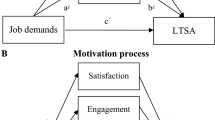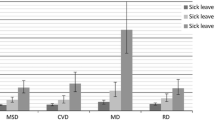Abstract
The objective of this study was to investigate the effect of health and work-related factors as predictors of subsequent sickness absence when experiencing common infections (common cold, flu-like illness, and gastroenteritis). Self-administered questionnaire data were used (baseline n = 12,140). To perform the analysis, employees reporting common infections in the final questionnaire were selected. Employees reporting sickness absence due to common infections were compared with a group who stayed at work during an infection. Multivariate survival analysis revealed no significant effects of job demands, decision latitude, or job strain on absence in workers experiencing common infections. Low levels of commitment (risk [RR] 1.22; confidence interval [CI] 1.03—1.44) and low job satisfaction (RR 1.36; CI 1.13—1.164) increased the chance of being absent during a common cold. Also, having a long-standing disease (RR 1.22; CI 1.05—1.41) and fatigue (RR 1.20; CI 1.05—1.37) increased the chance of being absent during a common infection. Having an executive function decreased the chance of being absent. We conclude that absence during a common cold is partly influenced by motivational factors in work, in contrast to more severe common infections which are more health related. Insight in factors related to absenteeism are important as a start for preventive measures to reduce sickness absence.
Similar content being viewed by others
References
Aronsson, G., Gustafsson, K., & Dallner, M. (2000). Sick but yet at work: An empirical study of sickness presenteeism. Journal of Epidemiology and Community Health, 54, 502–509.
Beurskens, A. J., Bultmann, U., Kant, I. J., Vercoulen, J. H., Bleijenberg, G., & Swaen, G. M. (2000). Fatigue among working people: Validity of a questionnaire measure. Occupational and Environmental Medicine, 57, 353–357.
Bourbonnais, R., & Mondor, M. (2001). Job strain and sickness absence among nurses in the province of Quebec. American Journal of Industrial Medicine, 39, 194–202.
Bültmann, U., De Vries, M., Beurskens, A. J. H. M., Bleijenberg, G., Vercoulen, J. H. M. M., & Kant, I. J. (2000). Measurement of prolonged fatigue at work in the Maastricht Cohort Study: Determination of a cutoff point. Journal of Occupational Health Psychology, 5, 411–416.
Bültmann, U., Kant, I. J., Kasl, S. V., Beurskens, A. J. H. M., & Van den Brandt, P. A. (2002). Fatigue and psychological distress in the working population: Psychometrics, prevalence, and correlates. Journal of Psychosomatic Research, 52, 445–452.
Bültmann, U., Kant, I. J., Van Amelsvoort, L. G. P. M., Van den Brandt, P. A., & Kasl, S. V. (2001). Differences in fatigue and psychological distress across occupations: Results from the Maastricht cohort study on fatigue at work. Journal of Occupational and Environmental Medicine, 43, 976–983.
Cohen, S., & Williamson, G. M. (1991). Stress and infectious disease in humans. Psychological Bulletin, 109, 5–24.
Cox, D. (1972). Regression models and life tables. Journal of the Royal Statistical Society Series B, 34, 187–220.
Feeney, A., North, F., Head, J., Canner, R., & Marmot, M. (1998). Socioeconomic and sex differentials in reason for sickness absence from the Whitehall II study. Occupational and Environmental Medicine, 55, 91–98.
Gründemann, R. W. M., Smulders, P. W. G., & De Winter, C. R. (1993). Handleiding vragenlijst arbeid en gezondheid [Manual, questionnaire on work and health]. Lisse, The Netherlands: Swets & Zeitlinger.
Jansen, N., Kant, I. J., Van Amelsvoort, L., Nijhuis, F., & Van den Brandt, P. (2003). Need for recovery from work: Evaluating short-term effects of working hours, patterns and schedules. Ergonomics, 46, 664–680.
Kant, I. J., Beurskens, A. J. H. M., Schröer, C. A. P., Nijhuis, F. J. N., Van Schayck, C. P., Van den Elzen, H. J., et al. (2000). De Maastrichtse Cohort Studie naar langdurige psychische vermoeidheid in de arbeidssituatie [The Maastricht Cohort Study on fatigue at work]. Tijdschrift voor Bedrijfsen Verzekeringsgeneeskunde, 8, 226–232.
Karasek, R. A. (1979). Job demands, job decision latitude, and mental strain: Implications for job redesign. Administrative Science Quarterly, 24, 285–311.
Karasek, R. A. (1985). The Job Content Questionnaire and User’s Guide (version 1.1). Los Angeles: University of Southern California, Department of Industrial and Systems Engineering.
Karasek, R. L., & Theorell, T. (1990). Healthy work: Stress, productivity and the construction of working life. New York: Basic Books.
Kivimaki, M., Sutinen, R., Elovainio, M., Vahtera, J., Rasanen, K., Toyry, S., et al. (2001). Sickness absence in hospital physicians: 2 year follow up study on determinants. Occupational and Environmental Medicine, 58, 361–366.
Kristensen, T. S. (1991). Sickness absence and work strain among Danish slaughterhouse workers: An analysis of absence from work regarded as coping behaviour. Social Science and Medicine, 32, 15–27.
Macintyre, S., & Pritchard, C. (1989). Comparisons between the self-assessed and observer-assessed presence and severity of colds. Social Science and Medicine, 29, 1243–1248.
Marmot, M., Feeney, A., Shipley, M., North, F., & Syme, S. L. (1995). Sickness absence as a measure of health status and functioning: From the UK Whitehall II study. Journal of Epidemiology and Community Health, 49, 124–130.
Mohren, D. C. L., Jansen, N. W. H., Kant, I. J., Galama, J. M. D., Van den Brandt, P. A., & Swaen, G. M. H. (2002). Prevalence of common infections among employees in different work schedules. Journal of Occupational and Environmental Medicine, 44, 1003–1011.
Mohren, D. C. L., Swaen, G. M. H., Borm, P. J. A., Bast, A., & Galama, J. M. D. (2001). Psychological job demands as a risk factor for common cold in a Dutch working population. Journal of Psychosomatic Research, 50, 21–27.
Mohren, D. C. L., Swaen, G. M. H., Kant, I. J., Borm, P. J. A, & Galama, J. M. D.(2001). Associations between infections and fatigue in a Dutch working population: Results of the Maastricht Cohort Study on fatigue at work. European Journal of Epidemiology, 17, 1081–1087.
Mohren, D. C. L., Swaen, G. M. H., Van Amelsvoort, L. G. P. M., Borm, P.J.A., & Galama, J.M.D.(2003). Job insecurityasarisk factor for common infections and health complaints. Journal of Occupational and Environmental Medicine, 45, 123–129.
Niedhammer, I., Bugel, I., Goldberg, M., Leclerc, A., & Guéguen, A. (1998). Psychosocial factors at work and sickness absence in the Gazel cohort: A prospective study. Occupational and Environmental Medicine, 55, 735–741.
Niedhammer, I., Goldberg, M., Leclerc, A., Bugel, I., & David, S. (1998). Psychosocial factors at work and subsequent depressive symptoms in the Gazel cohort. Scandinavian Journal of Work Environment and Health, 24, 197–205.
North, F. M., Syme, S. L., Feeney, A., Shipley, M., & Marmot, M. (1996). Psychosocial work environment and sickness absence among British civil servants: The Whitehall II study. American Journal of Public Health, 86, 332–340.
Peter, R., & Siegrist, J. (1997). Chronic work stress, sickness absence, and hypertension in middle managers: General or specific sociological explanations? Social Science and Medicine, 45, 1111–1120.
Rael, E. G., Stansfeld, S. A., Shipley, M., Head, J., Feeney, A., & Marmot, M. (1995). Sickness absence in the Whitehall II study, London: The role of social support and material problems. Journal of Epidemiology and Community Health, 49, 474–481.
Rees, D., & Cooper, C. L. (1993). Research note: Reliability of self-report sickness absence data in the health service. Health Services Management Research, 6, 140–141.
Smith, A. P. (1990). Respiratory virus infections and performance. Philosophical Transactions of the Royal Society of London. Series B Biological Sciences, 327, 519–528.
Smith, C. B., Golden, C. A., Kanner, R. E., & Renzetti, A. D., Jr. (1980). Association of viral and Mycoplasma pneumoniae infections with acute respiratory illness in patients with chronic obstructive pulmonary diseases. The American Review of Respiratory Disease, 121, 225–232.
Suzuki, T., Yanai, M., Yamaya, M., Satoh Nakagawa, T., Sekizawa, K., Ishida, S., et al. (2001). Erythromycin and common cold in COPD. Chest, 120, 730–733.
Vahtera, J., Kivimäki, M., & Pentti, J. (1997). Effect of organisational downsizing on health of employees. Lancet, 350, 1124–1128.
Vahtera, J., Kivimäki, M., Pentti, J., & Theorell, T. (2000). Effect of change in the psychosocial work environment on sickness absence: A seven year follow up of initially healthy employees. Journal of Epidemiology and Community Health, 54, 484–493.
Van Veldhoven, M., & Meijman, T. F. (1994). Het meten van psychosociale arbeidsbelasting met een vragenlijst: De vragenlijst beleving en beoordeling van de arbeid (VBBA) [The measurement of psychosocial job demands with aquestionnaire (VBBA)]. Amsterdam: NIA.
Vercoulen, J. H., Swanink, C. M., Fennis, J. F., Galama, J. M., van der Meer, J. W., & Bleijenberg, G. (1994). Dimensional assessment of chronic fatigue syndrome. Journal of Psychosomatic Research, 38, 383–392.
Voss, M., Floderus, B., & Diderichsen, F. (2001). Physical, psychosocial, and organisational factors relative to sickness absence: A study based on Sweden Post. Occupational and Environmental Medicine, 58, 178–184.
Author information
Authors and Affiliations
Corresponding author
Additional information
This study is part of the Maastricht Cohort Study on fatigue at work. The Maastricht Cohort Study participates in the Netherlands concerted research on “fatigue at work” granted by the Netherlands Organisation for Scientific Research (NWO Grant no. 580—02.254).
Rights and permissions
About this article
Cite this article
Mohren, D.C.L., Swaen, G.M.H., Kant, I. et al. Fatigue and job stress as predictors for sickness absence during common infections. Int. J. Behav. Med. 12, 11–20 (2005). https://doi.org/10.1207/s15327558ijbm1201_2
Issue Date:
DOI: https://doi.org/10.1207/s15327558ijbm1201_2




